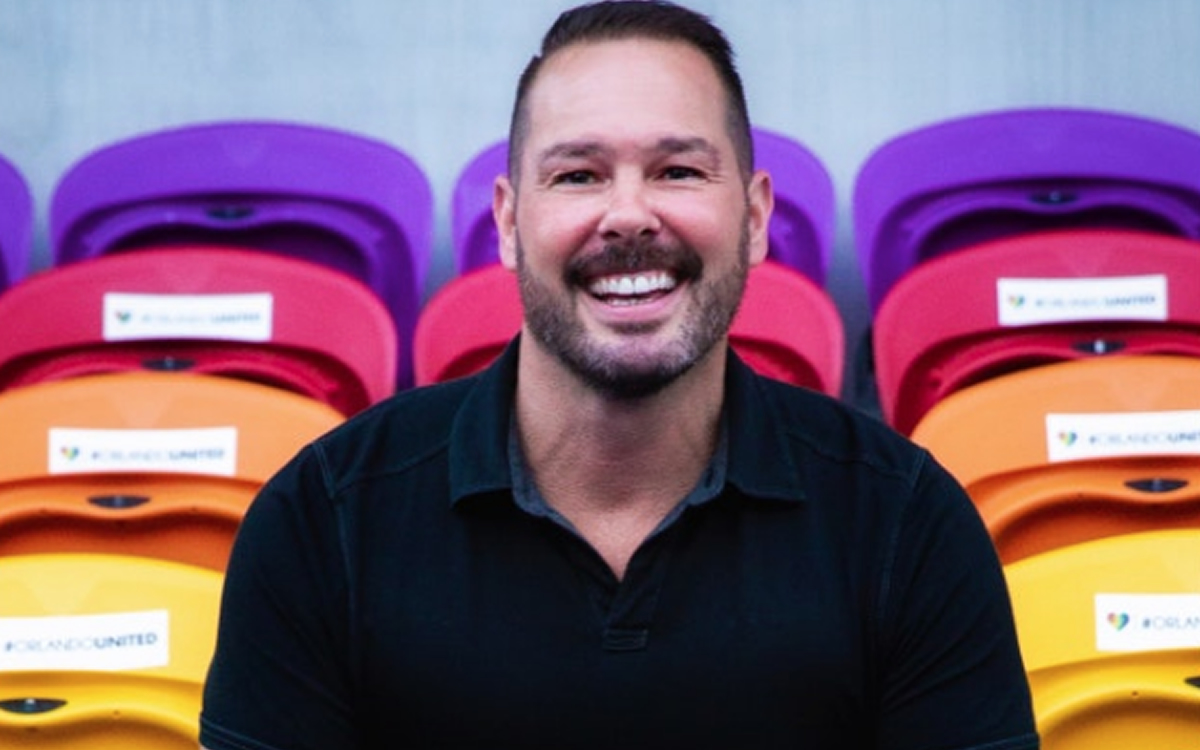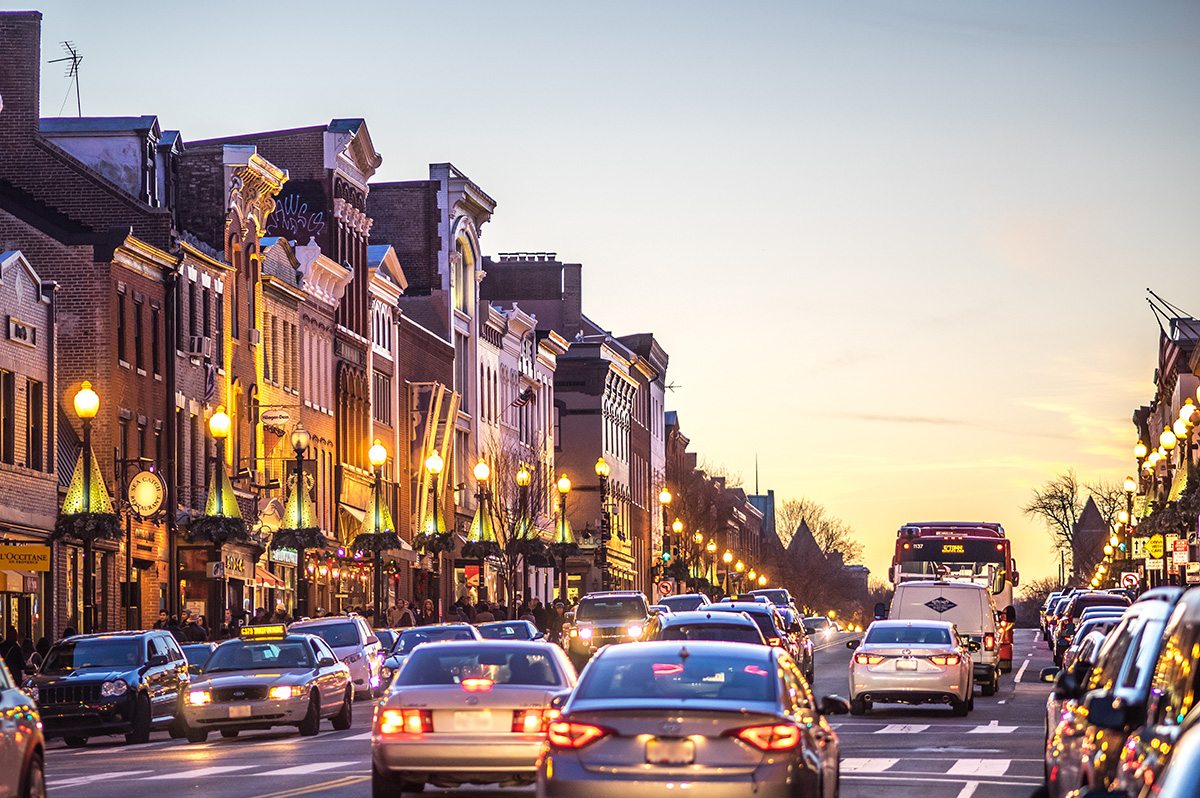Financial
Fla. ‘Pride Leadership’ firm survives pandemic to face anti-LGBTQ legislation
‘Are gay leaders better? Of course we are!’

(Editor’s note: This is the sixth in a multi-part summer series of stories taking a closer look at how a group of diverse LGBTQ entrepreneurs survived and thrived during the pandemic. The series is sponsored by the National LGBT Chamber of Commerce. All installments in the series are available on our website.)
Dr. Steven Yacovelli has spent more than 25 years delivering diversity training and developing LGBTQ leaders, but after surviving a nearly half-million-dollar loss during the pandemic, the “Pride Leadership” author and Top Dog Learning Group co-founder now fears legal repercussions from Florida’s “Stop W.O.K.E. Act.”
“I can go to a Florida-based client and potentially both the company and an employee could now sue me as the deliverer of the diversity training,” Yacovelli told the Blade. “That training is now potentially illegal because of the Act.”
Top Dog Learning Group is a diversity and inclusion consulting firm based in Orlando and has been delivering training, to include leadership development for the LGBTQ community since 2002, initially as Yacovelli’s “side hustle” while a corporate executive.
At the height of the pandemic’s economic crisis in 2020, Yacovelli said he lost nearly half of his business earnings in two weeks. They were able to survive and recover mostly due to his previous experience with Zoom and other virtual platforms.
But while they could increase their instructional capacity by going virtual, and grow through the crisis, the current impact of Florida’s anti-LGBTQ legislation now threatens his small business.
In April, Florida Gov. Ron DeSantis (R), whom conservative voters in a 2024 presidential election straw poll chose over former President Donald Trump for the second year in a row, signed the new law he dubbed the “Stop Wrongs Against our Kids and Employees Act.” It took effect July 1, despite First Amendment legal challenges.
The Florida law, though targeting the alleged teaching of critical race theory in public schools, also prohibits instruction that “compels” employees or students to believe privilege or oppression “is necessarily determined by his or her race, color, sex, or national origin.”
This legislation, and the popularly known “Don’t Say Gay” bill passed earlier, have served to decrease Florida’s score on Out Leadership’s 2022 State Level Business Climate Index, published amid a cascade of anti-LGBTQ measures pursued across state legislatures.
New York’s LGBTQ business climate ranked No. 1 for the second year in a row, earning 93.67 out of 100 points, while South Carolina scored last with 33.63 points.
Florida, ranked 31, and Oklahoma, ranked 49, lost points for their “Don’t Say Gay” bills among other anti-LGBTQ legislation.
“LGBTQ-friendly environments are business-friendly environments,” Todd Sears, Out Leadership founder, told Axios in June.
Florida’s “Stop W.O.K.E. Act” also vaguely states that an individual shouldn’t feel “discomfort, guilt, anguish, or any other form of psychological distress” as a result of the training experience due to their “race, color, sex, or national origin.”
This “discomfort” ban worries Yacovelli as he facilitates difficult conversations in a currently accepting community.
“I look at this as a taxpayer and as a human who lives here,” he said. “But the good news is I live in a very inclusive community because of the Pulse [shooting] and for other reasons. We’ve got each others’ back.”
Yacovelli said his local government and representatives have been very supportive, “but it’s hard.”
The problem of capital
When he was between jobs in 2008, after having been terminated from an executive position without explanation (Florida is an “at-will” state meaning an employer can fire an employee without cause), he followed his friend and co-founder, Ruth Bond, to Paris where he had an epiphany.
In a Paris cafe, he saw a simple yet elegant logo for a French telecommunications company and decided it was time to design a similar, simple logo for his side-hustle and move it into full-time reality.
Years later, he now sees the comforting spirit of his “fur-daughter” Ella, a mini-Labradoodle who died from cancer last summer, in the friendly dog visitors encounter on the company’s website.
“2008 wasn’t a good time to start a business,” Yacovelli said. “But there’s never going to be a good time. You’ll always find an excuse not to do this, but put that aside. Whether it’s the economy, or your own limited finances – just put that all aside and just do it.”
Access to startup capital has been a historic problem for minority business owners. The Federal Reserve Banks reported in 2018 that limited access to credit was a “compounding factor that hurts the underlying health of minority-owned small businesses.”
Many, like Yacovelli, turn to personal funds to get their dream off the ground.
“I was self-funded,” Yacovelli said. “But on the advice of a friend, I took out one small business loan. And thank goodness I did, because I had an established relationship with a bank when COVID hit.”
During the height of the pandemic, the Paycheck Protection Program was administered through banks, limiting access to the survival funding, according to a Brookings Institute report in 2020.
Brookings also pointed out that closing the financial and other disparities could add millions more new small businesses to the U.S. economy and with them more jobs.
The National LGBTQ Chamber of Commerce states LGBTQ-owned businesses contribute more than $1 trillion to the U.S. economy, and in 2015 more than 900 certified LGBTQ-owned businesses created more than 33,000 jobs across the country.
But pandemic challenges continue.
“In the years since the start of the COVID-19 pandemic, LGBTQ+ businesses have faced severe financial challenges and many are at risk of permanently closing,” Zack Hasychak, Director of Membership Outreach at the Human Rights Campaign, told the Blade.
To help LGBTQ businesses, HRC teamed up with Showtime to start their “Queer to Stay” initiative. For two years the partnership awarded funds to 30 LGBTQ-owned businesses across the country and has committed to supporting at least 25 businesses this round.
Applications are accepted via their website until Aug. 31.
The U.S. Small Business Administration is also shining a spotlight on LGBTQ-owned small businesses.
SBA Deputy Press Director Cecelia Taylor told the Blade about the Elevating Small Business webinar series in June that celebrated LGBTQ small businesses across the country while focusing on financial wellness and the importance of equity and opportunity.
“Equity is a top priority for me and for the Biden-Harris administration, and we believe all of America’s entrepreneurs deserve a level playing field, regardless of zip code, race, gender, gender identity, or sexual orientation” said SBA Administrator Isabella Casillas Guzman in a Pride month statement.
“During COVID, we’ve learned how critical equitable access is to surviving and thriving, and at the SBA we are working to build better connections to and for the 1.4 million LGBTQ+ owned businesses in communities across this country,” Guzman said.
Still, Yacovelli emphasized the need for the federal government to step up and make the process of procuring contracts easier.
“The federal government is the largest opportunity for contracts,” he said. “Yet, the process to get them is insanely hard. That’s a missed opportunity.”
Yacovelli said it took a week away from his business to complete a “dissertation-type application” only to have it “go into a black hole” without any feedback.
“It was for diversity training for 911 operators,” he said, stunned by why he didn’t hear back about his application. “Coach me so I can make the application better. It took us a week to get this packet done, and that’s a week I didn’t work on any client proposals.”
But despite challenges, Top Dog grew to exceed its pre-pandemic levels, making 2021 its best year to date.
“Are gay leaders better?” asked Yacovelli who literally wrote the book on “Pride Leadership,” which has been widely praised as influential by multiple business and political leaders. “Of course we are! We’re fabulous. I looked at my queer siblings in leadership roles and moving our community forward in areas of equality and justice. They exercise competencies all leaders could use.”
“You play with a lot of leaders in my business,” Yacovelli, a.k.a “The Gay Leadership Dude,” told the Blade. “You start to see patterns of behaviors for leaders that are crushing it and those that are crashing and burning.”
In his book “Pride Leadership,” Yacovelli combines academic insights gained though his doctorate in education and his years as a corporate leader to identify six leadership traits: being authentic, leading with courage, having empathy, effective communication, building relationships, and influencing organizational culture.
Yacovelli pointed out that the LGBTQ coming out process also involves using these leadership skills to navigate that tough line between being authentic and respecting the feelings and experiences of others.
“You have those difficult conversations. You’re having empathy for yourself and for the person receiving the news for the first time,” he said. “That one experience can be translated into leadership courage, and those traits are the foundation for a really effective leader.”
He stated that for trans siblings to live their lives authentically is powerful, and to channel that energy into a leadership role is using their “rainbow superpowers.”
“And we freakin’ need it now more than ever,” he added.
Real Estate
Celebrate the power of homeownership this Fourth of July
Owning a home is powerful act of self-determination

This Fourth of July, celebrate more than independence: celebrate the power of LGBTQ+ homeownership. Explore resources, rights, and representation with GayRealEstate.com, the trusted leader in LGBTQ+ real estate for over 30 years.
Home is more than a house: it’s a symbol of freedom
As the fireworks light up the sky this Fourth of July, LGBTQ+ individuals and families across the country are not just celebrating the nation’s independence — they’re celebrating personal milestones of freedom, visibility, and the right to call a place their own.
For many in the LGBTQ+ community, owning a home represents more than stability — it’s a powerful act of self-determination. After generations of discrimination and exclusion from housing opportunities, more LGBTQ+ people are stepping into homeownership with pride and purpose.
Why homeownership matters to the LGBTQ+ community
While progress has been made, LGBTQ+ homebuyers still face unique challenges, including:
- Housing discrimination, even in states with legal protections
- Limited access to LGBTQ+ friendly realtors and resources
- Concerns about safety and acceptance in new neighborhoods
- Lack of representation in the real estate industry
That’s why the Fourth of July is a perfect time to reflect not just on freedom as a concept, but on how that freedom is expressed in the real world — through ownership, safety, and pride in where and how we live.
Finding LGBTQ+ Friendly Neighborhoods
One of the top concerns for LGBTQ+ buyers is whether they’ll feel safe, accepted, and welcome in their new neighborhood. Thanks to evolving attitudes and stronger community support, many cities across the U.S. now offer inclusive, affirming environments.
Some of the best cities for LGBTQ+ home buyers include:
- Wilton Manors, Fla. – A vibrant LGBTQ+ hub with strong community ties
- Palm Springs, Calif. – A longtime favorite for LGBTQ+ homeowners
- Asheville, N.C. – Progressive and artsy, with growing LGBTQ+ visibility
- Portland, Ore. – Inclusive, eco-conscious, and diverse
- Philadelphia, PA – Rich in history and LGBTQ+ community leadership
When you work with an LGBTQ+ friendly realtor, you get insight into more than property values — you get a real perspective on where you’ll feel most at home.
Navigating the real estate process with confidence
Whether you’re a first-time gay homebuyer or preparing to sell your home as an LGBTQ+ couple, it’s essential to understand your rights and options. Here are a few key tips:
1. Work with a trusted LGBTQ+ real estate agent
Representation matters. A gay realtor, lesbian real estate agent, or LGBTQ+ friendly agent understands the unique concerns you may face and advocates for you every step of the way.
Use GayRealEstate.com to connect with LGBTQ+ real estate agents near you. For over 30 years, we’ve helped LGBTQ+ buyers and sellers find their ideal home and a professional who respects their identity.
2. Know your legal protections
While federal law (via the Fair Housing Act and Supreme Court rulings) prohibits housing discrimination based on sexual orientation or gender identity, enforcement can vary by state. Make sure to research:
- State-level housing discrimination laws
- Local LGBTQ+ protections and resources
- What to do if you experience discrimination during a transaction
3. Secure inclusive financing
While most lenders follow fair lending rules, it’s smart to seek out banks or credit unions with LGBTQ+ inclusive policies and a history of non-discriminatory lending practices.
4. Plan for the future as a family
For same-sex couples, especially unmarried partners, it’s vital to review how you’ll hold the title, designate beneficiaries, and plan your estate.
Ask your agent or attorney about:
- Joint tenancy with right of survivorship
- Living trusts
- Powers of attorney and healthcare proxies
Selling a home as an LGBTQ+ homeowner
If you’re listing your home, working with a gay-friendly real estate agent ensures your identity and story are honored — not hidden — in the process.
Highlight:
- Your community connections
- Your home’s role in creating a safe space
- Local LGBTQ+ resources to attract like-minded buyers
Showcasing the full value of your home includes sharing what it meant to live there authentically and safely.
Your home, your freedom
The Fourth of July reminds us that freedom isn’t just an abstract idea — it’s lived every day in the spaces where we find comfort, love, and belonging. For the LGBTQ+ community, the right to own and thrive in a home is part of the larger journey toward full equality.
At GayRealEstate.com, we believe every LGBTQ+ person deserves:
- A safe place to live
- A community that welcomes them
- An advocate in the home buying or selling process
Ready to make a move?
Whether you’re dreaming of your first home, upgrading with your partner, or selling a space that helped shape your identity, GayRealEstate.com is your trusted partner. With our nationwide network of gay realtors, lesbian real estate agents, and LGBTQ+ friendly professionals, we make your journey smooth, respectful, and informed.
Visit GayRealEstate.com to:
- Search LGBTQ+ friendly homes
- Connect with inclusive real estate agents
- Access free guides for buyers and sellers
- Protect your rights and get expert advice
This Fourth of July, celebrate more than independence — celebrate your freedom to live, love, and own with pride.

Did you melt like the Wicked Witch of the West this week?
As summer temperatures rise, keeping your home or apartment cool during a heat wave can become both a comfort issue and a financial challenge. One of the most effective ways to keep a home cool is to prevent heat from entering in the first place. Sunlight streaming through windows can significantly raise indoor temperatures. Consider the following solutions:
• Close blinds or curtains during the hottest parts of the day. Blackout curtains or thermal drapes can reduce heat gain by up to 30%.
• Install reflective window films to block UV rays and reduce solar heat without sacrificing natural light.
• Use outdoor shading solutions such as awnings (yes, the ones you removed because they were “dated”) and shutters to limit direct sunlight.
Fans are a cost-effective way to circulate air and create a wind-chill effect that makes rooms feel cooler.
• Ceiling fans should rotate counterclockwise in the summer to push cool air down.
• Box fans or oscillating fans can be placed near windows to pull in cooler evening air or push hot air out.
• Create a cross-breeze by opening windows on opposite sides of your home and positioning fans to direct airflow through the space.
• For an extra cooling effect, place a bowl of ice or a frozen water bottle in front of a fan to circulate chilled air.
To optimize natural ventilation, open windows early in the morning or late in the evening when outdoor temperatures drop. This allows cooler air to flow in and helps ventilate heat that built up during the day.
Appliances and electronics generate a surprising amount of heat. To reduce indoor temperatures:
• Avoid using the oven or stove during the day; opt for no-cook meals, microwave cooking, or grilling outside.
• Run heat-producing appliances like dishwashers and clothes dryers in the early morning or late evening.
• Unplug electronics when not in use, as even standby power can add heat to your space.
• Switching to energy-efficient LED lightbulbs can also reduce ambient heat compared to incandescent lighting.
If you do use an air conditioner, maximize its effectiveness by:
• Setting it to a reasonable temperature—around 76–78°F when you’re home and higher when you’re away.
• Cleaning or replacing filters regularly to maintain airflow and efficiency.
• Sealing gaps around doors and windows to prevent cool air from escaping. (Didn’t we all have a parent who said, “Close the door. You’re letting all the cool out?”)
• Using a programmable thermostat to optimize cooling schedules and reduce energy use.
If it is not cost-prohibitive, adding insulation in attics and walls can greatly reduce heat transfer. Solar panels that reflect heat can also help, as well as offset the cost of their installation. Adding weatherstripping around doors and windows, sealing cracks, and using door sweeps can make a significant difference in keeping heat out and cool air in.
Natural and eco-conscious methods can also help cool your home.
• Snake plants, ferns, or rubber trees can improve air quality and slightly cool the air through transpiration.
• White or reflective roof paint can reduce roof temperatures significantly.
• Cooling mats or bedding can make sleeping more comfortable without cranking up the A/C.
For renters or those who can’t make permanent modifications, there are still plenty of ways to keep cool.
• Use portable fans and A/C units instead of built-in systems, making sure they are the correct size for your space.
• Removable window film or static cling tinting can reflect heat without violating your lease.
• Install tension rod curtains or temporary blackout panels instead of hardware-mounted window coverings.
• Add draft blockers and weatherstripping tape that can be applied and removed without damage.
• Cover floors with light-colored rugs to reflect heat rather than absorb it.
• If allowed, use temporary adhesive hooks to hang reflective materials or light-filtering fabrics over windows.
Even if your space is warm, you can still take steps to help your body stay cool.
• Wear light, breathable fabrics like cotton or linen.
• Stay hydrated and avoid caffeine or alcohol during peak heat hours.
• Take cool showers or use damp cloths on your neck and wrists to bring your body temperature down.
Keeping your home or apartment cool in the summer doesn’t have to be expensive or energy-intensive. With a few adjustments such as blocking sunlight, optimizing airflow, using fans effectively, and making renter-friendly upgrades, you can create a more comfortable indoor environment while keeping energy bills in check.
Valerie M. Blake is a licensed Associate Broker in D.C., Maryland, and Virginia with RLAH @properties. Call or text her at 202-246-8602, email her at DCHomeQuest.com, or follow her on Facebook at TheRealst8ofAffairs.
Real Estate
The world’s on fire and D.C. is on sale (sort of)
Prices are up, but then again, nothing makes sense anymore

ICE is disappearing people, revered government agencies are shuttering, and who knows if we’ll be in World War III next week? But can you believe prices in D.C. are actually still up 6.3% since last year? It doesn’t make sense, and perhaps that does make sense, because nothing seems to make any sense any more.
That said, there are some parts of our market that are truly suffering. The interest rates, which have been up, up, up for about four years now, are the ongoing rain on our market’s military parade. Combine that with 75,000 federal employees taking a buyout nationwide, and DOGE cuts eliminating around 40,000 federal jobs in the District (per estimates by the D.C. CFO), not to mention thousands of other job losses in non-governmental organizations due to funding and program cuts, and you’ve got a case of uncertainty, and downright unaffordability in the pool of otherwise would-be buyers.
This has had a marked impact on properties that starter-home buyers and low- to mid-level employees would otherwise buy, most notably condominium and cooperative apartment units. These properties have already slowed in our market thanks to the profound impact that higher interest rates have had on their monthly carrying costs—pair that with job insecurity, and a lot of condos are proving to be very difficult to sell indeed.
So how is the average sale price up in our market?
The increase is almost entirely due to the resounding strength of the single-family home market, especially in upper Northwest D.C., where it is still quite common to see bidding wars, even on properties pushing past the $3M mark. It seems that buyers in that echelon are less impacted by a few percentage points in the interest rate, and less concerned about their job security. Notably, those buyers are often married with children and have an absolute need for more space, must stay in the area due to one spouse’s job, or the kid’s friend group, regardless of whether the cost of owning is thousands of dollars more per month than it would have been in 2020 or 2021. The continued appreciation in these neighborhoods defies imagination.
So, what to do if you are not one of those lucky enough to be shopping for a $3M home? The short answer: wait. If you want more space, rent your current place out and learn the joys of being a landlord while someone else pays your mortgage. Need the equity from your current home to buy your next place? Get a home equity line of credit, or loan, and pull the equity out of your current place to buy the next one. Or—and I have never recommended this before in 21 years of being a Realtor—rent for a few years. Sure, I’d love to list and sell your condo so you can climb the real estate ladder, but it might just be a waste of time, money or both if you could just ride out this storm and sell in a DOGE-less future.
All this said, there are some condos that seem to be immune from this recent negative news. Anecdotally, it feels like it’s the truly special ones that do just fine no matter the market. Our recent listing in Capitol Hill had a view from every one of its 15 windows of the Supreme Court. Sold in five days with six offers. Another condo was on the top two floors of a townhouse and had the coolest black wood floors that gleamed like a grand piano. Sold in four days at full price.
So, all is not for naught if you have a condo or home in an area that people want to be in, with nice space, light, amenities and a certain je ne sais quois. And, as long as we have a democracy in a few years, my experience says our market will be back, stronger than ever, really soon.
David Bediz is a Realtor and mortgage loan broker for the Bediz Group LLC and Home Starts Here, LLC. Reach him at [email protected].


















